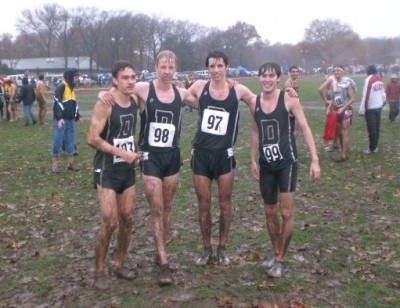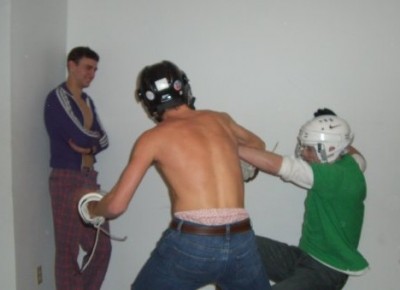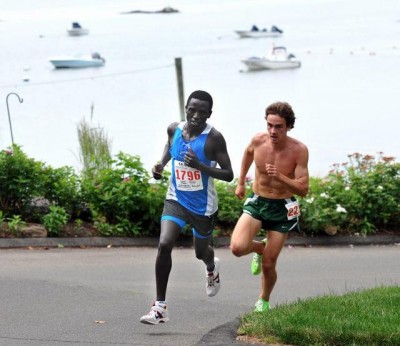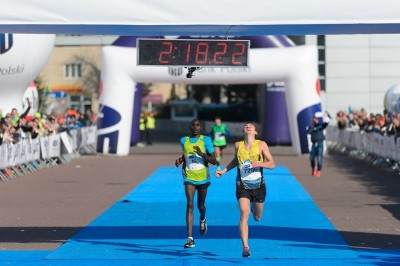Meet The Most Interesting Man In Running: Chris Zablocki’s Long Road To Los Angeles
Did you hear about the time Chris Zablocki raced three marathons in three weeks? What about the night he tried to hitchhike from Orlando to Jacksonville — and won a marathon two hours later? Did you know his training regimen once included throwing around a rock named Matt Pelletier?
Among his friends, the stories about Chris Zablocki are the stuff of legend. And they’re all true. Meet the Most Interesting Man in Running.
By Jonathan Gault
February 10, 2016
Note: Over the next week, most of LetsRun.com’s coverage will focus on the elites — the men and women racing at this weekend’s U.S. Olympic Marathon Trials who have a chance to represent the U.S. in Rio. But the vast majority of runners in Los Angeles have an extremely low chance of making the team. For them, the race is the culmination of a journey that can range from a few months to a lifetime, and every one of those athletes has a story. I wanted to highlight one of those stories on LetsRun, honoring one runner that embodied the spirit of the Trials to represent the masses. This is that story.
Full disclosure: I know Chris Zablocki. He was my college teammate. In searching for someone to profile, I spitballed with another college teammate and as soon as Zablocki’s name came up I immediately realized I had to write this story. He is without a doubt the most unique, interesting person that I have ever come across in the running world. I hope that by the time you finish this story, you will understand why.
November 14, 2009, was a dark, rainy day in Boston. The first drops began to fall before sunrise, and when Franklin Park played host to the MIAA Eastern Massachusetts Cross Country Championships that morning, rain pelted over 1,800 high schoolers who turned out to race.
So when Chris Zablocki and his Dartmouth College teammates decamped from the Newton Marriott and made the short drive to Franklin Park for that afternoon’s NCAA Division I Northeast Regional Cross Country Championships, they had a reasonable idea of what to expect. The reality was much worse.
The Franklin Park 5k course repeats itself in stretches, with athletes covering parts of the main field, known as Playstead, as many as three times. The 10k course that Zablocki and the rest of the competitors would run is even more repetitive — they would have to traverse some parts of the Playstead loop five separate times during the race. The combination of rain and eight high school races before the collegiate action got started meant that the ground was totally torn up by the time of the Northeast Regional. Save for a few meters of road, mud covered every square inch of the course, almost all of it underwater. The drier parts featured half an inch to an inch of standing water; in the wettest portions, it went halfway up the runners’ calves. Playstead was beyond waterlogged; even with half-inch spikes, it was impossible to gain traction in one 100-meter stretch as runners’ shoes sunk helplessly into the grass and mud.
It was under these circumstances that Chris Zablocki ran the final — and finest — cross country race of his collegiate career. Zablocki, who had struggled at the Ivy League Championships (Heps) two weeks earlier, finishing as Dartmouth’s third man (17th overall) was eager to make amends and as he emerged from the Wilderness section of the course and made the turn toward Playstead, he was firmly in contention for an NCAA individual spot. Running as Dartmouth’s #1 man, Zablocki ran in a group with Binghamton’s Erik van Ingen, Cornell’s Nate Edelman and Brown’s Christian Escareno, along with a few Syracuse and Iona athletes whose places did not matter since both schools qualified as a team. With Harvard’s Dan Chenoweth cruising to a qualifier up front, that left four guys for three NCAA spots. You do the math.
As they entered Playstead, the runners descended a short, steep downhill a little over 400 meters from the finish line. Pushing his body to the limit in pursuit of an NCAA bid, Zablocki lost his balance in the mud and tumbled to the ground. He rose quickly and sprinted, but the damage had been done. He crossed the finish line exhausted, soaked and covered in mud from head to toe, streaks of brown running across his cheeks and large clumps of mud around his calves. His shoes were so muddy that it was impossible to tell their original color. Zablocki placed 14th overall in 31:24, five seconds back of Escareno, the final individual qualifier.
Instead of preparing for a journey to Terre Haute, Ind., for his first trip to the NCAA Championships, his collegiate cross country career was now over courtesy to a fall in the final 500. Adding insult to injury, he’d also finished one second back of his old high school teammate Forrest Misenti of Syracuse, which earned him a punch in the face thanks to a pre-race bet (details to come below).
This was Chris Zablocki’s favorite race in college.
***
Spend time with Zablocki, now 27, and you quickly realize that he’s one of a kind. It starts with his voice — not quite a lisp, but different enough to make you pause the first time you hear it loudly announce Zablocki’s presence. Zablocki, 5’10’, 147 lbs. with a mop of brown hair residing atop a face that’s usually smiling, doesn’t look like your typical runner, either. The dude is jacked, with pecs that would be more at home on a football player.
He didn’t luck into that physique. In college, Zablocki’s bedtime routine included push-ups and jumping jacks. In the weight room, he’d put the rest of the Dartmouth team to shame. Regular pull-ups weren’t challenging enough for Zablocki, so he would grab a belt or a length of rope and tie a 45-pound weight or two around his waist before hoisting himself upwards.
When weights aren’t available, he improvises. When he was studying at med school on the Caribbean island of Sint Maarten, Zablocki would toss around rocks on the beach. Before that, when he was in the Marshall Islands on a teaching fellowship, he took a piece of driftwood and hung it from the roof of his house as a makeshift pull-up bar. Even back in the U.S., he still employs Rocky IV-like training from time to time. At home in Connecticut, he found a 50-pound rock and started throwing it in his back yard while doing post-run lunges. The rock even got a name – Matt Pelletier – after one of his road racing rivals.
“To read the story and find out that he’s literally throwing a rock around with my name on it, that’s intimidating,” Pelletier told Level Renner.
Zablocki’s unorthodox strength routine is not the only thing that sets him apart from the field at the 2016 U.S. Olympic Marathon Trials, a race in which Zablocki will compete on February 13 in Los Angeles. In the year before the Trials, many marathoners will cut back and run only one marathon. In 2015, Zablocki ran three — in three weeks. On September 27, he won the Ikano Robin Hood Marathon in Nottingham, England, in 2:24:22. On October 4, Zablocki finished second at the Standard Chartered Jersey Marathon in the Channel Islands off the coast of Normandy, France, in 2:20:06. And on October 11, Zablocki took third at the PKO Poznan Marathon in Poland, running 2:18:20. So not only did Zablocki run three marathons in three weeks — one on the English side of the English Channel, one in the middle of it and one on the European side — he got significantly faster in each one. A month after Poznan, Zablocki ran the Valencia Marathon. His 2:15:39 time was a personal best by almost two minutes.
In all, between November 23, 2014, and November 15, 2015, Zablocki ran 13 marathons, winning four, running two personal bests and averaging 2:21:32. Zablocki broke 2:21 seven times in 2015; per Tilastopaja.com, no other American accomplished the feat more than three times. In 2013, he did something similar, putting together a six-week stretch that included a 2:23:26 win at the Tallahassee Marathon on February 3, a 2:21:29 runner-up showing at the Albany Marathon on March 2 and a 2:17:49 win (a 2:22 pb) to win the Virginia Beach Shamrock Marathon on March 17.
| Zablocki’s marathons, 11/23/14 – 11/15/15 | |||
| Date | Location | Time | Place |
| 11/23/2014 | Philadelphia | 2:19:20 | 4th |
| 12/28/2014 | Jacksonville | 2:27:41 | 1st |
| 1/18/2015 | Carlsbad | 2:24:53 | 3rd |
| 2/8/2015 | Tallahassee | 2:20:31 | 2nd |
| 3/7/2015 | Albany | 2:18:57 | 1st |
| 3/22/2015 | Puerto Rico | 2:26:25 | 1st |
| 4/20/2015 | Boston | 2:20:35 | 20th |
| 6/20/2015 | Duluth | 2:17:26 (PB) | 19th |
| 8/30/2015 | Quebec City | 2:25:35 | 1st |
| 9/27/2015 | Nottingham | 2:24:22 | 1st |
| 10/4/2015 | Jersey | 2:20:06 | 2nd |
| 10/11/2015 | Poznan | 2:18:20 | 3rd |
| 11/15/2015 | Valencia | 2:15:39 (PB) | 16th |
“If I had to describe Chris, it would be that he’s very much a one-off,” said his coach, Allison Benton. “He’s not like any other athlete that I’ve worked with. His approach is a free spirit. He’s not restricted by the conventions and the rules and that has huge advantages for him because he’s able to explore boundaries that other people wouldn’t go towards.”
Benton met Zablocki at a race in England last fall, where he’s doing surgery rounds for med school at St. Richard’s Hospital in the south coast town of Chichester. Benton, who is based in Brighton, a 45-minute train ride away, coached several of the area’s top athletes and after watching Zablocki win, offered to add him to her training group. Zablocki, who had been self-coached since graduating from Dartmouth in 2010, agreed.
Benton offered some advice before Valencia and suggested Zablocki target 2:15:30; he wound up just nine seconds off. Since then, she’s been more involved in his training, convincing him in December 2015 that he could not run any more marathons until LA.
“He’s still got a lot of plans to run a lot of marathons in the spring, but for this buildup, for LA, we had a conversation and it went along the lines of, ‘To have any chance in these Trials, you have to make a huge improvement and doing the same thing again isn’t going to make a difference. So we need to do something different.’ And he said, ‘Okay, it’s only 10 weeks, let’s give it a go.'”
To say that Benton has changed the structure of Zablocki’s training is selling it short, because that implies that a structure existed in the first place. Zablocki doesn’t log his miles and never runs with a watch; frequently he would depart for a run with the idea of simply running “as hard as the legs feel like going.” So if Zablocki’s legs felt like racing marathons in consecutive weeks, his mind didn’t put up a fight.
“Recovery wasn’t a word that really featured in his vocabulary,” Benton said.
Zablocki doesn’t ice his muscles after his races. After marathon weekends last fall, he’d return to St. Richard’s, where he works from 8 a.m. to 4 or 5 p.m. five days a week, doing rounds in the morning before examining patients and observing in the operating theater or clinics in the afternoon. After a few days of no running, he’d feel the itch to get going again; by Wednesday, he would feel good enough to resume moderate intervals. Zablocki gets his sleep — seven or eight hours a night — and eats right, devouring a plate of amaranth, hard-boiled eggs, salmon and a towering pile of kale (Zablocki’s favorite) for dinner most nights. But he doesn’t know for sure where his body’s Wolverine-like power to heal itself stems from.
“I guess people like Ben True and Galen Rupp and Chris Derrick, they get born with super-fast legs and I get born with … fast recovery legs,” Zablocki said. “I haven’t delved into it too much.”
Benton has had to tweak her usual approach to training when it comes to Zablocki.
“Instead of writing a detailed program, I’ve kept it much broader in terms of an overview for the marathon buildup and finding the specific sessions that would be key for him,” Benton said. “It’s been so much easier to work together than I thought it would be. He’s very open to the suggestions that I’m putting forward. The Chris story for me is just about this guy who loves to run every day and who has the opportunity to run every day hard. What we’ve been trying to do is shift that approach just a little bit without losing the essence of Chris Zablocki.”
How to define the essence of Chris Zablocki? Perhaps it’s easiest to trace his path to Los Angeles, beginning with…
Stop 1: Dartmouth College
Chris, the oldest of Richard and Mary Ann Zablocki‘s five children, arrived at Dartmouth in the fall of 2006. Though most of his cross country teammates believed he was a walk-on, Zablocki himself wasn’t sure about that fact until he was already well into his career. Then one day a teammate told Zablocki that when they received the list of incoming freshman that year, his name was not on the list.
“At dinner, we were discussing whether God exists and I said, ‘He must because He helped me get in here!'” Zablocki said.
Head coach Barry Harwick had been interested in Zablocki after he ran 9:35 for 3200 and 9:52 for the 3000-meter steeplechase as a junior at Xavier (Conn.) High School, but Zablocki’s senior year was a disaster. He finished 142nd at the Connecticut state meet in cross country; in the spring, he struggled to break 10:00 (and sometimes 11:00) in the 3200. Only after his spring season concluded with an 11:07 3200 at the Southern Connecticut Conference Championship did Zablocki find out he had been battling anemia the entire year.
Even once he overcame that, there didn’t appear to be anything special about Zablocki.
“The first time I met him or said anything to him was when we were doing Grasse Road,” said fellow walk-on and classmate Jason Lyon, referring to one of Dartmouth’s staple early-season hill workouts. “The only person who had a worse day on the Grasse Road workout was him. Both of us had no flats, just sneakers. I remember wanting to quit then and there. We just kind of walk-jogged back to the locker room.”
Zablocki’s first race didn’t go any better. Dartmouth sent a JV squad to the Williams Purple Valley Classic. Zablocki finished 46th overall, running 28:00 for the 8k course. Zablocki was the slowest guy on Dartmouth’s seven-man JV team, putting him at the absolute bottom of the Big Green depth chart.
Zablocki’s teammates didn’t know what to make of his personality at first, either.
“The first impression I think that anyone gets from him is that he’s a really awkward guy,” classmate John Schroeder said of Zablocki. “He talks kind of different and you’re kind of wondering ‘Wow, this guy is really sheltered.’ It quickly became apparent that he went to an all-boys school and had a very sheltered upbringing and didn’t know a lot about how the world worked.”
Indeed, one day another teammate, Alex Hall, noticed Zablocki eating rice at the dining hall. With his hands. He quickly stepped in and instructed Zablocki that most people used a utensil to eat rice. Zablocki quickly became a team favorite.
“He’s always just super nice and the thing that I liked a lot about him was that he didn’t have a filter,” Lyon said. “He would just say things every so often that you’d go, ‘That’s odd.’ He’s such a genuine person that he doesn’t think that what he says is going to offend people.”
But to portray Zablocki as a simplistic goofball is a disservice. He held a 3.36 GPA as a history major at Dartmouth and is also a skilled painter.
“I had the same basic reaction that most people had when people meet Chris,” said Ron Shaiko, a professor in the government department and the faculty advisor for the Dartmouth cross country team. “Intelligence doesn’t emanate from him, but the more you get to know him, [you realize] he is a complex and smart person.”
For a group project during one of Shaiko’s classes, Zablocki had to give a presentation in front of the New Hampshire state congress, where the chief justice of the New Hampshire Supreme Court was heading a commission on juvenile justice.
“Chris had to present what they found,” Shaiko said. “I think he did a great job and was the leader of that team. When push came to shove, he really did quite well.”
***
Zablocki — known simply as Blocki to his friends — may have survived without running at Dartmouth, but the sport allowed him to thrive. He relied on Harwick for workouts but experimented with a variety of supplemental exercises. Zablocki sums up his philosophy thusly:
“It’s kind of trial and error. If something makes you feel better, you should do it.”
So he lifted. He did push-ups. One day at the end of a run on a warm day, Zablocki and his teammates decided to cool off by jumping into the Connecticut River, which runs right next to campus. Kicking in the river made his legs feel good, so Zablocki decided to add it to his routine. Later that year, Zablocki and Lyon went down to the Connecticut to go canoeing.
“I thought he was going to rent the canoe with me, but he wanted to swim,” Lyon said. “I thought, ‘It’s a beautiful day, go for it, man.'”
Lyon paddled the canoe downstream for 30 minutes, Zablocki swimming at his side. Then they decided to turn around. Zablocki tried to return to the dock, but he had forgotten to account for one thing: the current. After 15 minutes of straining with little progress, he hopped into the canoe with Lyon and paddled back. From then on, Zablocki made sure to always start his swims against the current.
Zablocki’s training philosophy wasn’t limited to just exercise. The night before Pre-Nats as a senior in 2009, Zablocki had a pint (just one) of his favorite beer, a Guinness. He ran great the next day, finishing as Dartmouth’s top man. So the before the next race, Dartmouth’s conference meet, Zablocki tried two Guinnesses. The result: Zablocki finished 17th overall, the third finisher for the Big Green. He limited himself to one pre-race stout from then on.
Hall remembered Zablocki’s tradition when he decided to run the Harpoon Octoberfest Race with Zablocki in 2012. The night before, Hall pumped Zablocki full of wine and Keystone Light. And the morning of the race, he convinced Zablocki to pound a tall boy Keystone, which he did (mostly to humor Hall).
“I was hoping to handicap him so much that he’d run terribly,” Hall said. “[Another friend], Neal Graves, convinced him to take it easy the first mile (Zablocki ran it in around 5:30). Blocki brought his average mile down to 5:10 and ran 18:39 for the 3.6-mile course in what still stands as the course record.”
Though Dartmouth is surrounded by a plethora of trails, Zablocki’s training consisted mainly of two runs: Oak Hill and Spank. Oak Hill featured a network of wide, winding cross-country ski trails that became runnable from late spring through the fall. It was easy to get lost on Oak Hill, and Zablocki often did (in the beginning), but he fell in love with the turns, the trees and the soft ground covered by leaves of all colors, especially when he felt banged-up (or, in Blocki-speak, whenever “his knee was being a jerk”).
“It was just like a rollercoaster through the forest, so it made you want to go even faster and faster,” Zablocki said. “It had the perfect running surface. It was nice and squishy and just loosened up your leg muscles. If it was, say, your IT band causing some irritation, it was loosened up by the end of the run.”
When Oak Hill became snowed-over during the winter, Zablocki’s desire to run on soft surfaces drew him to Spank, a hilly road run in Norwich, Vt. The run itself is around eight miles, and there’s an add-on — a mile loop on a dirt road that runs past the childhood home of two-time Olympian Andrew Wheating — that turns the run into Long Spank. Zablocki would run this add-on multiple times, day after day, transforming an eight-mile run into one that could stretch anywhere from 10 to 18 miles. It was not uncommon for Zablocki to run “Septa-Spank” for his long runs: seven loops of the same one-mile add-on.
“It was a nice loop,” Zablocki said. “If I have a favorite, I don’t mind doing it over and over and over and over again.”
Through repetition and literally countless miles (remember, Zablocki doesn’t wear a watch), Zablocki willed himself into a solid collegiate distance runner. He earned PBs of 14:33 and 29:56 at Dartmouth and excelled in XC, just missing out on that NCAA berth as a senior. Day after day, he pounded his body. And not just on the trails around Hanover.
The Dartmouth team once had a tradition called Helmets & Gloves — at the end of the season, two guys at a time would grab hockey helmets and gloves and try to beat the crap out of each other in a series of one-on-one battles. Zablocki, as he did in all forms of physical activity, went all-out, windmilling his arms furiously to the point of exhaustion. Once, after the guy he was fighting ducked unexpectedly, one of Zablocki’s wild swings caught a girlfriend of one of the guys on the team by mistake. The two broke up later that night.
“His approach was unorthodox,” said Lyon, who fought — and lost to — Zablocki. “I don’t think he had ever been in a fight and never had any training in the ring. He would come at you like a thousand cats. If you could take it for three rounds, he was going to be pretty out of breath.”
Indeed, only one man was said to be better than Zablocki at Helmets & Gloves: Ben True.
And remember that punch in the face Zablocki earned after losing to Forrest Misenti at NCAA Regionals in 2009? Zablocki and Misenti, along with fellow high school teammate Adam Vess, had made a bet before the race: whoever finished first among them got to punch the other two in the face.
“I thought it was a great idea,” Zablocki said.
Misenti ultimately decided to downgrade the punch to a light slap, but the video evidence was emailed to the Dartmouth squad to prove Zablocki had followed through.
***
Zablocki’s final race at Dartmouth, the 2010 NCAA Track & Field Championships East Preliminary Round in Greensboro, N.C., was a brutal one. He was entered in the 10,000 and the steamy conditions — temperatures in the 80s with humidity in the 70s — were awful for distance running. Eighteen of the 48 men in that race dropped out.
“Chris did not drop out,” Harwick recalled. “He does not do things like that.”
“They put a water station in lane four,” recalled Zablocki’s teammate Phil Royer. “However, this was Chris’ last race for Dartmouth and God-damnit if he was going to stop for water and lose that precious two seconds. So by the last few laps he had slowed down considerably and he had a vacant look in his eyes. On the straightaways, he was looking up and a little to the right. He somehow finished, but I had to guide him back to Barry and the crew because he was stumbling and saying things that didn’t make any sense.”
Zablocki graduated Dartmouth with no major championships, but he left a legacy that will not soon be forgotten.
“He never gave up on anything, whether it was a practice or a race,” Harwick said. “People always say that they’re getting 100% out of themselves. I think a lot of people say that, but at the end of the day, probably a relatively small percentage of runners actually do. I think that Chris was one of those people who was willing to take it to his physical limit and he did it pretty consistently.”
Stop 2: Jaluit Atoll, Marshall Islands
One day in the months leading up to Zablocki’s graduation from Dartmouth, an email popped into his inbox. It detailed a volunteer teaching program in the Marshall Islands, a group of Micronesian islands in the Pacific Ocean. Islands had always held an appeal to Zablocki and he had thought about pursuing teaching, so he applied and was accepted into the program.
Zablocki was assigned to Jaluit Atoll, population 1,788, and lived in a concrete house with a tin roof. There was electricity and running water (procured through a rainwater catchment system), but none of the time-wasting luxuries of American life — television, Internet, video games — to whittle away the hours when he wasn’t teaching history or chemistry (a subject he had to learn quickly after taking over for the previous teacher, who had died unexpectedly).
Zablocki hadn’t planned on continuing to run. But one day, during an introductory session, he went for a run with Justin Curtis, another college teammate who was teaching on a different island. Zablocki decided he wasn’t done with the sport yet. Jaluit Atoll comprises 91 islands, but the majority of its 4.38 square miles are concentrated on the main islet, also named Jaluit, which is 11 miles long but just 300 meters at its widest point. This fact limited Zablocki’s running routes to:
Option A: The jungle road, a palm tree-lined 10-mile route that ran the length of the island and offered views of the ocean. When it rained, the sticky mud would fill every inch of Zablocki’s shoes; when it was dry, he had to watch for sharp coral rocks hidden in the undergrowth.
Option B: The airstrip, 1,320 meters of gravel where planes would land.
The island was hot and humid — Jaluit’s location near the equator means 80-degree temps year-round — but that didn’t stop Zablocki. The jungle road quickly became the Marshallese version of Oak Hill and Spank, as he ran it day after day after day, only going to the airstrip when he needed a “track” session. His high school students, who had taken an immediate liking to Zablocki, quickly became fascinated by this mysterious running man.
“Every morning and evening, I saw him running,” said Peter Robert, one of Zablocki’s students, who was 17 at the time. “I was wondering where he was running to and how far. I wanted to join him.”
Other students followed Zablocki too, trying to keep up before he disappeared into the jungle. He decided to start a running club. About 20 boys signed up.
“During the first day, I didn’t even reach the destination, but I thought I was going to be paralyzed since my legs were so tired,” Peter said. “Then I walked. I was really hurt, and I almost gave up.”
This was not your average group of high schoolers. The islanders played basketball and sometimes ran short races but none had any experience with distance running. Footwear had something to do with it.
“The dorm was about 130 boys, and the boys’ dorm had about three pairs of sneakers,” Zablocki said. “So every day, you’d see the sneakers on a different boy.”
Zablocki did his best to remedy the situation. He had his sister, Ali, bring two-dozen pairs when she came to visit him and called on the Dartmouth team to donate old shoes. When his students ran out of socks, Zablocki gave them his own.
Slowly, Zablocki’s group ran longer and longer, first one mile, then two, three, all the way up to 10. One day, a representative from Kwajalein, one of the main islands, noticed Zablocki running and asked whether he’d be interested in running the Kwajalein Marathon. Zablocki agreed, then asked if any of his students were interested. Even though getting them up to 10 miles had been a struggle, several hands went up.
So Zablocki kept running with his students, often slowing to their pace to keep them motivated. He got a few of them to complete a 20-mile run out and back on the jungle road (stopping midway through for coconuts), and that was enough to convince the Marshall Islands National Olympic Committee to cover the cost of a flight for three athletes plus Zablocki to Kwajalein for the race.
“I had never [flown] in a plane before,” Peter said.
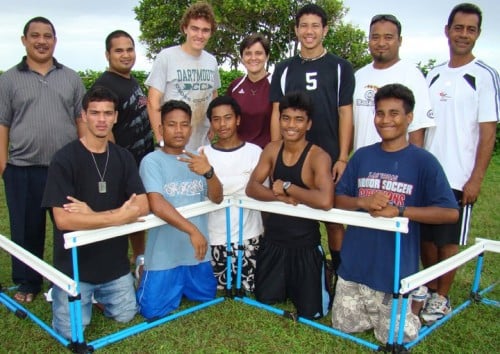 Zablocki (back row, third from left) coached Toralik (front, second from left), Robert (front, second from right) and Katlong (front, far right) to run a historic marathon in the Marshall Islands. Photo courtesy Marshall Islands Journal.
Zablocki (back row, third from left) coached Toralik (front, second from left), Robert (front, second from right) and Katlong (front, far right) to run a historic marathon in the Marshall Islands. Photo courtesy Marshall Islands Journal.
So in December 2010, Zablocki, Peter and two other students, Harrington Toralik and Casey Katlong, boarded a plane for Kwajalein. The United States has a missile testing base on the island and it was there that the race would be held: 10 laps around the base, starting at 4 a.m. to avoid the heat of the sun. During the race, Zablocki ran nine- and ten-minute miles with his athletes to ensure they didn’t go out too hard. It took them over four hours, but all four completed the 26.2-mile race. His athletes’ pride in their accomplishment was matched only by their coach’s pride in them.
“I have lived on Kwajalein Island since 1979,” Bob Sholar, custodian of the Kwajalein Running Club archives, told the Marshall Islands Journal after the race. “I can say that this is the first time a native Marshall Islander has run a marathon on Kwajalein since then.”
Peter kept running after the marathon, logging 10 miles a day on the jungle road, but once Zablocki left at the end of the year, his motivation dwindled. Zablocki’s time was up in the Marshall Islands; he had to move on to the next adventure.
“I miss my coach, and I wish he was still here,” Peter said.
Stop 3: Quantico, Virginia
Zablocki returned to the States in 2011 and decided in January 2012 that his next move would be to enroll in the Marines’ Officer Candidate School in Quantico, Va.; the idea of becoming a freedom fighter appealed to him. But Zablocki didn’t last long in the Marines. Always one to follow his own path, Zablocki did not mesh well with the buttoned-down structure of the military. He didn’t enjoy constantly being told to blouse his pants faster by his gunnery sergeants and didn’t like that he didn’t get the time to go running. His platoon mates spent most of their free time chowing down on endless meals at Denny’s; Zablocki longed for a more interesting existence.
And then there were the chits. Every day during mail call, the gunnery sergeant would hand out chits, or a reprimand letter from the platoon captain. Fail to tie your boots in a timely fashion? That’s a chit. Don’t pivot quickly enough in formation, forget your ammo, or shoot at the wrong target? Chit, chit, chit.
Zablocki earned 29. No one else got more than 12.
After a month in Quantico, he had had enough. He returned to Connecticut, worked at a running store and began racing again. He ran his first serious marathon in Philadelphia in 2011, clocking 2:24:14, and ran three more in 2012, getting down to 2:20:11 in Hartford in October.
Stop 4: Sint Maarten
Back at home, Zablocki thought about what he wanted to do with his life. Running was going well, but it didn’t pay the bills. He heard that there was a demand in the U.S. for family practice physicians. He had enjoyed helping people in the Marshall Islands, so why not become a doctor?
“I’ll be happy as long as I get to help patients and get to do some running on the side,” Zablocki said. “Those are the two things I care about mainly.”
Zablocki hadn’t taken many science classes at Dartmouth, so he enrolled at Central Connecticut State University and began to rack up the necessary credits to apply to med school. He settled on American University of the Caribbean School of Medicine in Sint Maarten, a constituent country of the Netherlands located off the northern coast of South America. Zablocki liked that he didn’t have to spend another year earning credits (as he would if he applied to a school in the U.S.), liked that the degree he would earn was licensed in every state and loved that he would get the chance to explore another island.
Zablocki had planned to give up running to focus on his studies, but…
“It turned out a lot of the people on the island really liked doing running races and triathlons so they made sure I came to races. I keep giving up the sport and people keep making me stop retiring,” Zablocki said with a smile.
One of those people was 2012 U.S. Olympian Donn Cabral, whose family owned a condo in Sint Maarten. Just as Zablocki had chased Cabral in high school (both are Connecticut natives) and college (Cabral went to rival Princeton), he now tried to keep up with him whenever Cabral visited Sint Maarten over the holidays.
So Zablocki kept racing. And racing. It didn’t matter where it was, if there was a start and a finish, Zablocki was interested. And he’d go to any lengths to get there on time.
Zablocki was scheduled to race the Jacksonville Marathon on December 28. A flight to Tampa from Sint Maarten was half the price of a flight to Jacksonville, so Zablocki decided to head to Tampa and rent a car for the 200-mile drive north. One problem: he had left his driver’s license at home. So after arriving in Tampa around 6 p.m. on the 27th, Zablocki found a bus going to Orlando and arrived there around 10:30. Unfortunately, the last bus heading from Orlando to Jacksonville that night was sold out. Zablocki decided to hitchhike and spent four hours walking around town, including a couple of unpleasant encounters with a man in a black Corolla who tried to proposition him for sex.
Finally, a little after 2 a.m., a cab making the rounds of the city’s bars pulled up.
“Where are you going?” said the driver, who introduced himself as Chris.
“Jacksonville,” Zablocki replied.
“I’ll drive you there,” Chris said.
Zablocki had to perform some cost-benefit analysis. Chris offered to drive him to Jacksonville for $200; the first-place prize was $500. But the race began in less than five hours and he was 141 miles from the start line.
“You think about it for a few minutes, I’ll go into the gas station and get a cup of coffee,” Chris told Zablocki.
Zablocki decided to go for it and he arrived in Jacksonville around 5 a.m. After checking in for the race, Zablocki lay down in a gym for an hour but couldn’t sleep. So he got up, inhaled some caffeine GUs and won the race by six minutes in 2:27:41.
“I just felt awful,” Zablocki said. “I was wondering when I was going to hit the wall. I took triple gels at every station.”
Stop 5: Chichester
After a couple of years — and plenty more races — Zablocki landed in Chichester for med school rotations. Though he estimates he’s racked up close to $25,000 in lifetime prize money, he remains unsponsored. He contacted Newton Running once but they weren’t interested. Sometimes he’ll get some gear from his friends at soundRUNNER, a running store in Connecticut. He hasn’t heard from anyone else.
“I guess I’m just sponsored by the streets,” said Zablocki.
But Zablocki doesn’t run for the money.
“I like just being outside,” Zablocki said. “And just going through the forest and fields and enjoying it. Other times, I really enjoy the man-to-man competition where it’s just your muscles and your heart and your mind and nothing else getting in the way, no cars or balls any of that sort of thing.”
Zablocki’s Olympic Trials buildup is almost complete, and the race has sneaked up on him.
“Oh yeah, it’s in nine days! Oh my gosh!” he told me when I mentioned the race to him last week. He’ll head out to LA on Wednesday.
Between his work at St. Richard’s and marathon training, Zablocki hasn’t had time to think about anything else. He’ll ride the train once or twice a week to work out with Benton, his coach, who rides alongside on a bike, timing him. That’s about all the excitement he’ll allow himself right now.
“I don’t do that much,” Zablocki said. “Some of the teachers in my school even send me letters telling me I should run less so I can be more professional. So I spend a lot of time on my schoolwork so I can tell them to look at my grades and be quiet and talk to the other students who aren’t doing as well.”
Zablocki doesn’t have a goal in mind for the Trials — he described his strategy as “just don’t think too f—— much, get out there and smash” — but Benton does. She thinks Zablocki is capable of 2:13:30, and he managed to run an 18-mile tempo at that pace a few weeks ago.
“If he gets to 2:13:30 in LA, then I honestly believe this guy has the potential to go 2:10,” Benton said. “His performance will have improved so quickly based on some structure in his training that he didn’t have before that I believe when he returns to the U.S., he needs to find a group because the potential is there.”
His college coach has also learned by now that anything is on the table when Zablocki races.
“When we’re watching the Trials on television, whether Chris is a favorite or not, if the lead pack goes through the half marathon at 1:04, I would not be surprised if Chris Zablocki is up there rubbing shoulders with everybody else,” Harwick said.
The 26.2 miles Zablocki runs in Los Angeles will mean the world to him — a chance to reunite with family, old teammates and rivals after spending much of the last five years overseas. For the longshots, the story is never the race; it’s the journey. And from Hanover to Jaluit, Sint Maarten to Chichester, no one has a journey as long — or as colorful — as Zablocki’s.
Discuss this article on our messageboard: MB: LetsRun, Meet The Most Interesting Man in Running – Chris Zablocki.
Are you a running fan? Play our free fantasy contest: LRC LetsRun.com Running Warehouse $200,016 Marathon Trials Prediction Contest.

